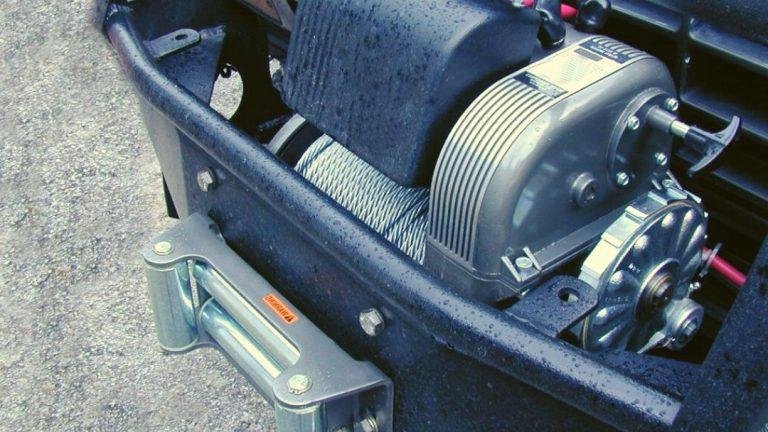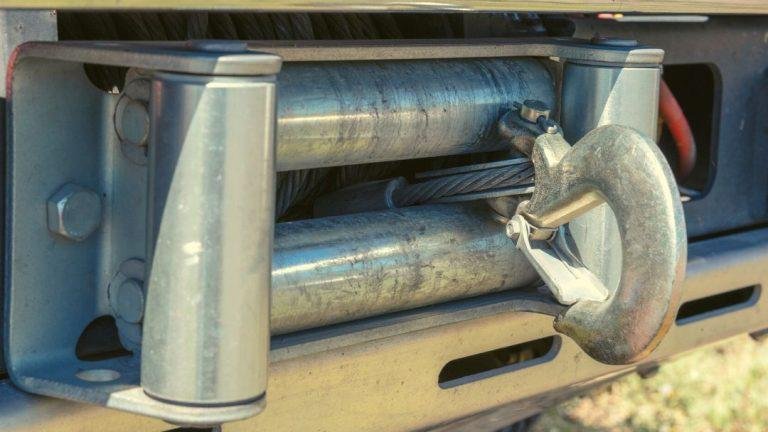Your ATV winch may just be clicking because of a faulty solenoid or a weak battery.
If your ATV winch is only clicking instead of engaging, it could be due to issues with the solenoid or electrical connections. Understanding the mechanism will help you troubleshoot and fix the problem effectively.
If you’ve ever encountered the frustrating issue of your ATV winch just clicking, you’re not alone. This common problem can leave you scratching your head and wondering what’s going on. But fear not! In this section, we will dive into the mechanics of an ATV winch to help you understand why it might be exhibiting this behavior.
So let’s get started!
How Does An ATV Winch Work?
An ATV winch is a powerful tool that allows you to pull heavy loads with ease. To understand why your winch is clicking, it’s essential to grasp how it works. Here’s a breakdown of the process:
- Electric motor: The electric motor serves as the powerhouse of the winch, converting electrical energy into mechanical energy.
- Gear train: The gear train is responsible for increasing the pulling power of the winch by gearing down the motor’s speed and increasing its torque.
- Drum: The winch drum is where the wire rope is wound. As the drum rotates, it reels in or releases the rope to pull or release the load.
- Wire rope: The wire rope is the primary means of connecting the winch to the load. It is wound around the drum and provides the necessary strength to handle heavy weights.
- Control switch: The control switch allows you to operate the winch, controlling its direction of rotation and enabling you to pull or release the load as needed.
Components Of An Atv Winch
To understand why your ATV winch is clicking, it’s crucial to familiarize yourself with its components. Here’s a list of the main parts:
- Solenoid: The solenoid acts as a switch, sending power to the winch motor when activated by the control switch.
- Battery: The battery supplies the electrical power needed to operate the winch.
- Circuit breaker: The circuit breaker protects the winch from electrical overload by automatically cutting off power to prevent damage.
- Wiring: The wiring connects all the electrical components, allowing the winch to function properly.
- Fairlead: The fairlead guides the wire rope onto and off the winch drum, preventing it from tangling or fraying.
- Hook: The hook is attached to the end of the wire rope and provides a secure anchor point for the load.
Common Issues With Atv Winches
Now, let’s address the common issues you might encounter with your ATV winch:
- Clicking sound: If your ATV winch just clicks when you try to use it, it could indicate a problem with the solenoid or the motor. A faulty solenoid may not be providing enough power to the motor, causing it to click but not engage.
- Freespooling: Freespooling occurs when the winch drum rotates freely without reeling in or releasing the wire rope. This issue could be due to a malfunctioning clutch or engagement mechanism.
- Wire rope tension: If the wire rope is too loose or tight, it can affect the winching operation. Proper tension ensures optimal performance and prevents damage to the winch.
- Electrical connection: Loose or corroded electrical connections can cause a loss of power or intermittent operation. It’s essential to check and clean all connections regularly.
Now that you have a better understanding of the mechanism behind your ATV winch and the common issues that can arise, you can troubleshoot and fix the problem with confidence. Remember to follow the manufacturer’s guidelines and consult a professional if needed.
Happy winching!

Troubleshooting The Clicking Sound
When an ATV winch only clicks, it may indicate a problem with the solenoid or a weak battery connection. Check these components to troubleshoot the clicking sound and ensure the proper functionality of your ATV winch.
Identifying The Clicking Sound
If you have ever encountered a frustrating situation where your ATV winch just clicks instead of engaging, you might be wondering what could be causing this issue. The clicking sound is often a sign of an underlying problem that needs to be addressed.
In this section, we will discuss how to identify the clicking sound, its possible causes, and the steps you can take to diagnose the issue.
Possible Causes Of The Clicking Sound
When your ATV winch clicks instead of turning, it can indicate several potential causes. Understanding these causes will help you troubleshoot and resolve the issue more effectively. Here are some possible reasons for the clicking sound:
- Battery: A weak or low battery can cause the winch solenoid to click without providing sufficient power to engage the winch motor.
- Winch solenoid: The solenoid is responsible for transferring power from the battery to the winch motor. A faulty solenoid can result in a clicking sound when it fails to transmit power properly.
- Motor brushes: Over time, the motor brushes inside the winch motor can wear out, leading to poor contact and causing the winch to click instead of turning.
- Wiring issues: Loose or damaged wiring connections can disrupt the flow of power to the winch motor, resulting in a clicking sound.
Steps To Diagnose The Issue
To diagnose the issue with your ATV winch, follow these simple steps:
- Check the battery: Start by inspecting the battery voltage using a multimeter. Ensure that the battery is charged and provides sufficient power to the winch.
- Examine the winch solenoid: Inspect the winch solenoid for any signs of damage or loose connections. Clean and tighten the connections if necessary.
- Inspect the motor brushes: Remove the winch motor cover and examine the motor brushes. If they appear worn or damaged, replace them with new ones.
- Check the wiring: Examine the wiring connections from the solenoid to the winch motor. Look for any loose or damaged wires and repair or replace them as needed.
- Test the winch: Once you have checked all the components, reassemble the winch and test it. If the clicking sound persists, it might be worth seeking professional assistance to further diagnose and fix the issue.
By following these troubleshooting steps, you can identify the cause of the clicking sound in your atv winch and take the necessary actions to fix it. Remember to always prioritize safety while working with electrical components and consult the manufacturer’s manual for specific guidance.
Fixing The Clicking Sound
Atv winches may emit a clicking sound due to a variety of reasons, such as a loose connection, low battery, or a faulty solenoid. Identifying and troubleshooting the specific cause can help resolve this issue and get your winch working smoothly again.
Why Does My ATV Winch Just Clicks: Fixing The Clicking Sound
If you’ve noticed that your ATV winch is producing a clicking sound instead of engaging and pulling the load, it’s important to address the issue promptly to avoid being stranded in unfavorable situations. Fortunately, the clicking sound is often a sign of a fixable problem within the winch’s electrical system or motor brushes.
In this section, we will explore the steps to check the electrical connections, test the solenoid, and replace the motor brushes.
Checking The Electrical Connections:
- Ensure that the winch is turned off and the ATV is parked securely.
- Examine the electrical connections, including the battery terminals, winch cables, and control switch connections.
- Verify that all connections are tight and free from corrosion or damage.
- Clean the battery terminals if necessary, using a wrench or battery terminal brush.
- Inspect the winch cables for any frayed or damaged sections, and replace them if needed.
- Ensure that the control switch connections are securely plugged in.
Testing The Solenoid:
- Locate the solenoid, generally mounted near the winch motor or on the winch itself.
- Carefully examine the solenoid for any visible signs of damage, such as melted or corroded parts.
- Check the solenoid’s connections for tightness and cleanliness, ensuring they are free from dirt or debris.
- Test the solenoid by turning on the ATV ignition, engaging the control switch, and listening for a clicking sound.
- If the solenoid clicks but the winch does not engage, the solenoid may need to be replaced.
Replacing The Motor Brushes:
- Locate the motor brushes, which are typically found on the sides of the winch motor.
- Carefully remove the motor brush caps by unscrewing them or using a small flat-head screwdriver.
- Inspect the motor brushes for wear or damage. If the brushes are excessively worn or show signs of chipping or melting, replacement is necessary.
- Remove the old brushes from their holders and replace them with new ones, ensuring they are properly seated.
- Secure the motor brush caps back in place.
- Test the winch to see if the clicking sound has been resolved.
By following these steps to check the electrical connections, test the solenoid, and replace the motor brushes, you can troubleshoot and resolve the clicking sound issue with your ATV winch. Remember, proper maintenance and regular inspections are key to keeping your winch in optimal working condition so that it’s ready for any adventure.
Frequently Asked Questions For Why Does My ATV Winch Just Clicks
How Do I Know If My Winch Motor Is Bad?
To determine if your winch motor is bad, check for a few common signs. First, make sure the motor isn’t overheating during use. You can test this by touching the motor casing after extended use; if it’s very hot, it may indicate a problem.
Additionally, listen for any unusual noises coming from the motor, such as grinding or clicking sounds. These can point to potential issues. Another indicator is if the winch is struggling to pull loads, or if it does not operate at all.
In such cases, the motor may be faulty. Lastly, inspect the motor’s wiring connections for any signs of damage or loose connections, as these can impact its performance. If you notice any of these signs, it’s advisable to consult a professional to diagnose and repair or replace the bad winch motor.
What Does Solenoid On Winch Do?
The solenoid on a winch operates as an electromagnetic switch that controls the power flow to the winch motor. It plays a crucial role in the winching process by engaging and disengaging the motor, allowing the winch to pull or release the load.
When activated, the solenoid uses an electrical current to create a magnetic field, which then attracts a metal plunger. This action completes the circuit and allows electricity to flow to the winch motor, causing it to rotate. When the solenoid is deactivated, the plunger is released and the circuit is broken, stopping the flow of electricity and stopping the winching action.
In summary, the solenoid on a winch is responsible for controlling the power that drives the winch motor, enabling the winch to pull or release loads efficiently.
Can You Bypass The Solenoid On A Winch?
Yes, it is possible to bypass the solenoid on a winch. By doing this, you can manually control the operation of the winch. However, bypassing the solenoid should only be done if you have a clear understanding of the risks involved.
It is important to note that bypassing the solenoid may void the warranty on your winch and could lead to damage or injury if not done correctly. If you are unsure about the process, it is recommended to consult the manufacturer’s instructions or seek professional assistance to ensure the proper and safe operation of your winch.
How Do You Test A Winch Solenoid?
Testing a winch solenoid is a straightforward process. Start by disconnecting the power supply and removing the solenoid cover. Next, use a multimeter to test the continuity and resistance of the solenoid coil. Connect the multimeter probes to the coil terminals and check for a reading within the specified range.
If there is no continuity or the resistance exceeds the recommended value, the solenoid is likely faulty. Additionally, you can test the solenoid’s activation by applying power to its control terminal. This should cause a click or audible sound. If the solenoid fails to activate, it may need to be replaced.
Remember to reassemble the solenoid and reconnect the power supply after testing. By following these steps, you can determine if a winch solenoid is functioning properly.
Conclusion
If your atv winch is only clicking and not working, there are a few potential causes to consider. First, check the connections and ensure they are secure and free from corrosion. Next, inspect the solenoid for any signs of damage or wear.
If necessary, replace the solenoid to see if that resolves the issue. Another possibility is a problem with the battery. Make sure it is fully charged and functioning properly. Additionally, it could be a motor issue, in which case it may need to be replaced or repaired.
It’s important to troubleshoot and identify the root cause of the clicking sound to ensure your ATV winch operates effectively when you need it most. Regular maintenance and inspections can help prevent issues and prolong the lifespan of your winch.




